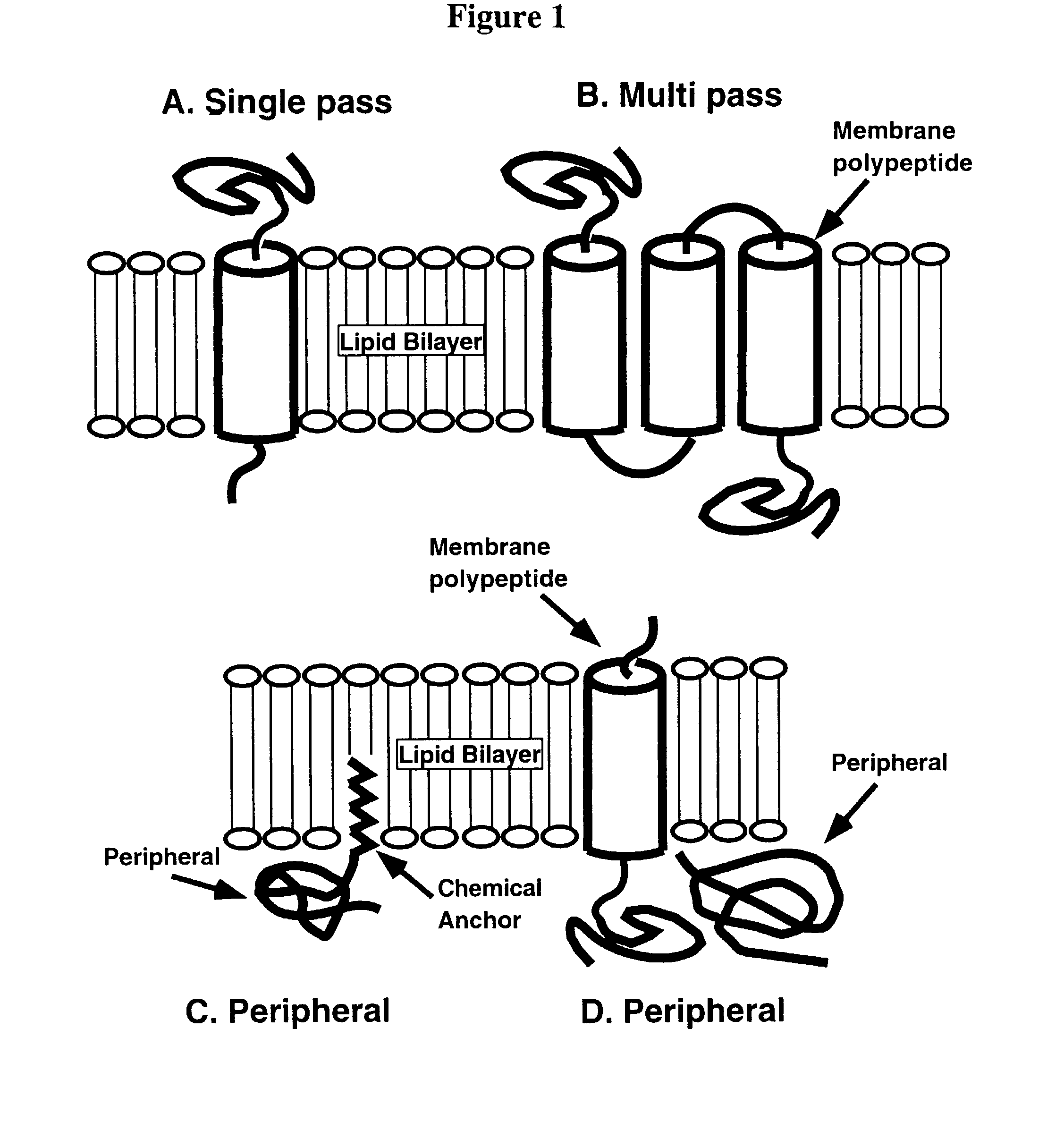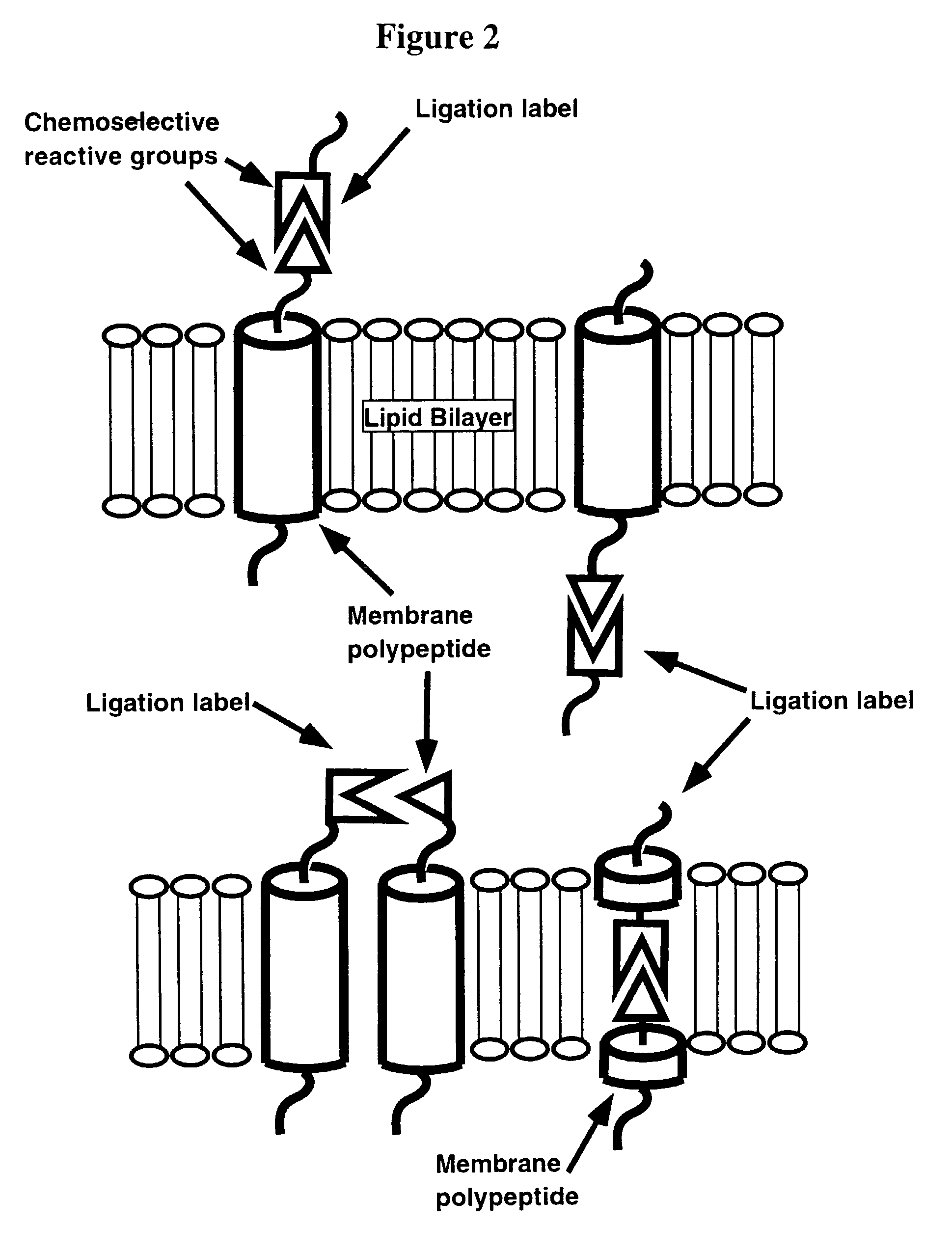Compositions for lipid matrix-assisted chemical ligation
a technology of lipid matrix and chemical ligation, which is applied in the field of membrane polypeptides, methods of preparation, assays, etc., can solve the problems of poor solubility of their hydrophobic polypeptide chains, difficulty in folding membrane proteins from unfolded polypeptide chains, and difficulty in overexpressing and isolating them in an environment suitabl
- Summary
- Abstract
- Description
- Claims
- Application Information
AI Technical Summary
Benefits of technology
Problems solved by technology
Method used
Image
Examples
example 1
Design and Synthesis of Bacteriorhodopsin Membrane Polypeptide
[0149]Bacteriorhodopsin functions as a light-driven proton pump in the purple membrane of halobacteria and has a characteristic seven helical structural motif. It is part of a family of retinal-binding proteins that includes the mammalian vision receptor, rhodopsin. Bacteriorhodopsin can be refolded from a fully denatured state into a functional, native protein, and its atomic structure is known. Segments of bacteriorhodopsin can also be designed which independently form a membrane bilayer spanning α-helix when incorporated into a lipid membrane (Hunt, et al., Biophysical Journal (1991) 59:400a).
[0150]A membrane polypeptide derived from the first transmembrane α-helix of bacteriorhodopsin and its first extracellular loop (corresponding to bacteriorhodopsin residues 5-42) is selected for native chemical ligation. The membrane polypeptide is modified so that the N-terminal Thr residue (corresponding to Thr5 of bacteriorhodo...
example 2
Design and Synthesis of Ligation Label
[0154]A C-terminal thioester-modified ligation label peptide EAQL (SEQ ID NO:4) designed for native chemical ligation to the lipid matrix-incorporated membrane polypeptide (SEQ ID NO:2) is synthesized manually on a PAM-thioester generating resin, cleaved and deprotected as described above. The crude peptide is precipitated in diethyl ether, taken up in 50% B and lyophilized. The peptide is purified by semi preparative reversed-phase HPLC (25-45% B over 45 minutes at 10 ml / min) and characterized by electrospray MS (obs. MW 647±1 kD, calc. 647 (average isotope composition)).
example 3
Preparation of CLP Matrix and Incorporation of Bacteriorhodopsin Membrane Polypeptide
[0155]Cubic lipidic phase matrices admixed with membrane polypeptide 3 (SEQ ID NO:3) are prepared following standard protocols by centrifugation of the lipid matrix constituents in a Haraeus Biofuge 13 table-top centrifuge. In particular, 75 μg of membrane polypeptide 3 (SEQ ID NO:3) is dissolved in 3 μl 200 mM Tris buffer containing 2% OG at pH 8. These polypeptide solutions are added to a 1.7 ml eppendorf tube containing 14.2 mg MO. Subsequently, 1.5 μl 200 mM Tris buffer (pH 8) is added to decrease the lipid:water ratio. The mixture is spun for 3 hours at 12,000 rpm at approximately 25° C. Formation of CLP's is indicated by the formation of optically clear, gel-like phases. These phases remain optically clear at room temperature for at least two months. Off-resonance Raman spectra excited at 514.5 nm is used to demonstrate that the addition of the membrane polypeptide does not perturb the membran...
PUM
| Property | Measurement | Unit |
|---|---|---|
| temperature | aaaaa | aaaaa |
| temperature | aaaaa | aaaaa |
| temperature | aaaaa | aaaaa |
Abstract
Description
Claims
Application Information
 Login to View More
Login to View More - R&D
- Intellectual Property
- Life Sciences
- Materials
- Tech Scout
- Unparalleled Data Quality
- Higher Quality Content
- 60% Fewer Hallucinations
Browse by: Latest US Patents, China's latest patents, Technical Efficacy Thesaurus, Application Domain, Technology Topic, Popular Technical Reports.
© 2025 PatSnap. All rights reserved.Legal|Privacy policy|Modern Slavery Act Transparency Statement|Sitemap|About US| Contact US: help@patsnap.com



